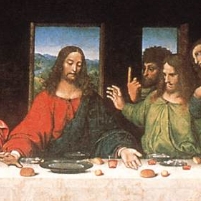Last Supper Paintings Reflect the New Obesity
Wednesday, March 24, 2010
 Leonardo da Vinci's "Last Supper"
Leonardo da Vinci's "Last Supper"
Jesus Christ and his disciples are eating better these days. A review of historical depictions of the famous Last Supper shows considerable increase in the amount of food presented to Jesus and his dinner guests, according to a research team from Cornell University.
Using advanced computer technology to examine and measure the food painted in 56 portraits from 1000 AD to 2000, researchers concluded the Last Supper has grown in abundance by nearly 70%. Plate size also has expanded, by 66%. The measurements were made by comparing the portions of food, bread and plates to the size of the average disciple’s head.
Writing in the International Journal of Obesity, Professor Brian Wansink, co-leader with his brother Craig of the research, said it’s not surprising that as the “last thousand years have witnessed dramatic increases in the production, availability, safety, abundance and affordability of food,” the portrayals of the Last Supper have been super-sized.
“We think that as art imitates life, these changes have been reflected in paintings of history’s most famous dinner,” says Wansink.
Brian Wansink has an unusually lively resume for a nutritional science professor. The co-author of such studies as “Shape of Glass and Amount of Alcohol Poured: Comparative Study of Effect of Practice and Concentration,” The Mystery of the Cabinet Castaway: Why We Buy Products We Never Use,” and “Eating Behavior and Obesity at Chinese Buffets,” Wansink served as the executive director of USDA’s Center for Nutrition Policy and Promotion during President George W. Bush’s second term.
-Noel Brinkerhoff, David Wallechinsky
Wansink Brothers Study Last Supper Art for “Portion Distortion” (by Marcia Poole, Sioux City Journal)
Last Supper helpings Have Grown (by Melissa Healy, Los Angeles Times)
The Largest Last Supper (International Journal of Obesity) (pdf)
Brian Wansink Biography (AllGov)
- Top Stories
- Unusual News
- Where is the Money Going?
- Controversies
- U.S. and the World
- Appointments and Resignations
- Latest News
- Trump to Stop Deportations If…
- Trump Denounces World Series
- What If China Invaded the United States?
- Donald Trump Has a Mental Health Problem and It Has a Name
- Trump Goes on Renaming Frenzy






Comments